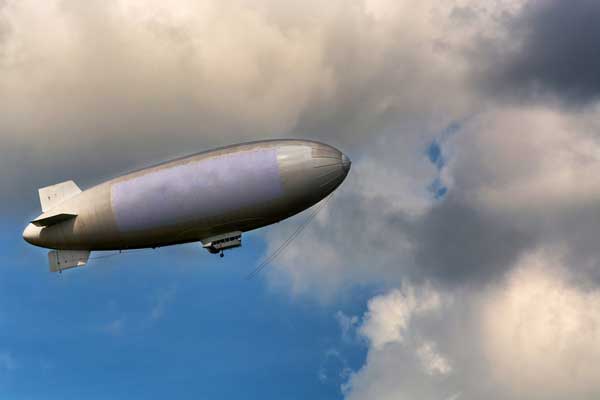Around five years ago, whispers of Sergey Brin’s secretive airship project at NASA Ames in Mountain View began circulating. The mystique surrounding this endeavor piqued my interest, leading to an obsession with discovering more. Although Sergey Brin was initially tight-lipped about his airship, over the past couple of years, I’ve managed to forge a connection with the mastermind behind bringing this remarkable project to life.
In this extensive blog article, we delve into the fascinating world of airships, focusing on Lighter Than Air’s Pathfinder One project. Prepare to be enthralled as we explore the history, design, and mission of this awe-inspiring endeavor.

The Resurgence of Airships
Almost a century ago, the Navy commenced the construction of airships in Ohio, intending to fly them to California for intelligence gathering and reconnaissance. Silicon Valley was once adorned with a sky filled with airships, performing remarkable feats. Let’s take a closer look at this golden era of airships and their eventual decline.
In the early 20th century, airships were hailed as marvels of engineering. The Navy’s airship program aimed to harness their potential for reconnaissance and intelligence gathering. These majestic giants ruled the skies, offering a unique perspective on the world below.
However, as technology evolved and planes became more prevalent, airships faced challenges. Negative perceptions and accidents led to a decline in their popularity. The once-thriving era of airships faded into history, until now.
The Rigid Airship Distinction
In contrast to the commonly known blimps, the Pathfinder One represents a revival of rigid airships. These airships possess a skeleton structure that defines their shape. Join us as we delve into the distinctions between rigid airships and blimps, and why Al believes in their resurgence.
Rigid airships are characterized by their internal framework, which gives them a distinct shape and structure. This design sets them apart from blimps, which lack a rigid frame. The Pathfinder One, as Al proudly explains, follows the tradition of rigid airships, combining the elegance of the past with modern innovations.
Al and his team are committed to reviving these hard-bodied airships, making use of non-flammable helium to ensure safety. It’s a journey back in time with a futuristic twist, and the results are nothing short of remarkable.
Modernizing the Airship Concept
The Pathfinder One project is a blend of tradition and innovation. Discover how modern technology, including electric motors inspired by quadcopters and carbon fiber materials, is revolutionizing airship design. Explore how these advancements aim to make air travel greener and more sustainable.
One of the most striking aspects of the Pathfinder One project is its blend of old-world charm and cutting-edge technology. The airship is equipped with electric motors mounted on pylons that can rotate, reminiscent of quadcopter technology. These motors allow for precise control, enabling the airship to lift vertically or move laterally with ease.
Additionally, the airship’s skeleton is constructed from carbon fiber, a material known for its strength and lightness. This innovation makes the Pathfinder One lighter and more durable than its predecessors, paving the way for a more sustainable future of air travel.
Inside the Pathfinder One
Although the interior of the Pathfinder One may seem unremarkable for a futuristic airship, it serves a specific purpose as an experimental vehicle. Learn about its potential applications beyond leisurely sky cruises and why disaster scenarios are at the heart of its mission.
Step inside the Pathfinder One, and you’ll find an interior that may not scream luxury, but it’s designed with a clear purpose. This experimental vehicle is not intended for leisurely sky cruises, but rather for testing and refining the technology behind it.
The true potential of the Pathfinder One lies in its ability to aid in disaster relief efforts. When disaster strikes, traditional infrastructure can be compromised, making it challenging to deliver essential supplies. Airships like the Pathfinder One can overcome these obstacles by transporting significant cargo to remote and inaccessible areas. It’s a game-changer in disaster response, offering scalability and versatility.
A Bright Future for Disaster Relief
(05:39) Explore how airships like the Pathfinder One can play a pivotal role in disaster relief efforts. With their ability to transport significant cargo to remote and inaccessible areas, they offer a lifeline during times of crisis. Discover the scalability of this technology and its potential to reshape disaster response.
In times of disaster, quick and efficient relief efforts can mean the difference between life and death. Traditional methods of transportation, such as roads and helicopters, often face limitations in these situations. This is where airships shine.
Airships have the potential to carry substantial cargo, up to 200 tons in some cases. Lighter Than Air’s approach is scalable, meaning that larger airships with even greater cargo capacity are within reach. These giants of the sky can be a lifeline for communities in need, providing critical supplies and support when roads are impassable and helicopters have limited range.
Conclusion
(06:28) As Lighter Than Air prepares to unveil the Pathfinder One to the world, the future of airships is on the brink of a remarkable resurgence. While challenges remain, the vision of a more sustainable, versatile, and eco-friendly mode of transportation and disaster relief is undeniably inspiring.
If you’re intrigued by the revival of airships and the boundless possibilities they offer, keep an eye on this white whale of innovation. The promise of extraordinary rides and a brighter future beckons, and as Al aptly put it, “It’ll be a great ride.”





